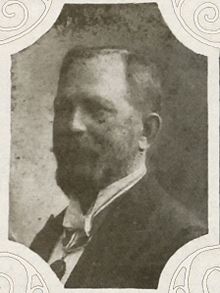Ignaz Bittmann
Ignaz Bittmann (born February 23, 1851 in Vienna ; † April 28, 1913 there ) was an important supplier of children's wardrobes during the Austro-Hungarian monarchy and ran a linen factory in Vienna.
biography
Ignaz Bittmann started his business in 1879 in a modest shop in Weihburggasse No. 2, where he started producing and selling simple linen. The young entrepreneur endeavored to deliver good, solid lingerie at reasonable prices. In a short period of time, he acquired a large number of customers and soon the need to open a second restaurant at Singerstrasse 8, where sales of new products such as dressing gowns , négligés , etc. began. The company owner closely followed the development of fashion in the relevant places and so he turned his interest to this article when the jersey waist came into use in Berlin . He soon realized that such ready-made items would easily find acceptance in Vienna and in fact it only took a short time to make them extremely popular. The women's understanding of the practicality of this new fashion had made Bittmann's idea a complete success. The rapidly increasing demand now prompted the domestic textile industry to turn to the manufacture of tricot fabrics, and so the fashion introduced by Ignaz Bittmann in Austria gave the impetus to establish a profitable domestic branch of production. At that time, the steady growth of the company required a significant spatial expansion of the business, and therefore the large premises of house No. 26 in Kärntner Strasse were adapted for business operations.
The tricot costume was also subject to change in fashion. It alone left a lasting effect. The ladies had a preference for distinctive blouses and so the jerseys were replaced by other fabrics, flannel for winter, batiste for summer, etc. Ignaz Bittermann lived up to this taste by producing selected products and from Vienna then took the blouse their victory run through the whole world. Around 1900 the jersey waistlines and suits were popular and sought-after items from the Bittmann company.
The company paid special attention to the manufacture of children's wardrobes. On numerous trips to Paris , London , Brussels and Berlin, Bittmann found out about these articles and used his experiences in such a way that the Viennese taste was also fully satisfied. His Viennese department store on Kärntner Strasse was mainly dedicated to this line of business as a “children's fashion palace”.
The strong sales employed several hundred workers, many of them for 10 to 15 years and some for even longer. The company's customers were not only in Austria, but also abroad. The products were awarded prizes at many exhibitions and received the highest prices in Paris , Vienna, Linz and Innsbruck as well as at the anniversary exhibition in 1898 .
Ignaz Bittmann, the founder and boss of the company, was recognized for his meritorious achievements by being awarded the title of imperial and royal purveyor to the court and was also awarded the Officer's Cross of the Royal Serbian Order of Takowa . By Emperor Franz Joseph I , he received in 1907, the Golden Cross of Merit with the crown .
The company, which Bittmann's son Rudolf (1880–1964) took over, was Aryanized after the annexation of Austria in 1938 , and the art collection was auctioned.
Individual evidence
- ↑ Georg Gaugusch : Who once was. The upper Jewish bourgeoisie in Vienna 1800–1938 . Volume 1: AK . Amalthea, Vienna 2011, ISBN 978-3-85002-750-2 , p. 250.
- ↑ Ignaz Bittmann. In: The large-scale industry of Austria. Ceremony for the glorious fiftieth anniversary of the reign of His Majesty the Emperor Franz Josef I, presented by the industrialists of Austria in 1898. Volume 6. Weiss, Vienna 1898, p. 202.
- ↑ Medal awards. (PDF; 2.9 MB) (No longer available online.) In: Neue Nacional-Zeitung. Jewish-political weekly. IX. Year, No. 30. Dr. SR Landau, July 5, 1907, p. 7 , formerly in the original ; Retrieved January 20, 2010 . ( Page no longer available , search in web archives ) Info: The link was automatically marked as defective. Please check the link according to the instructions and then remove this notice.
- ^ Meike Hopp: Art trade in National Socialism: Adolf Weinmüller in Munich and Vienna. , Böhlau, Cologne / Weimar / Vienna 2012, p. 263f
| personal data | |
|---|---|
| SURNAME | Bittmann, Ignaz |
| BRIEF DESCRIPTION | Austrian textile entrepreneur |
| DATE OF BIRTH | February 23, 1851 |
| PLACE OF BIRTH | Vienna |
| DATE OF DEATH | April 28, 1913 |
| Place of death | Vienna |


